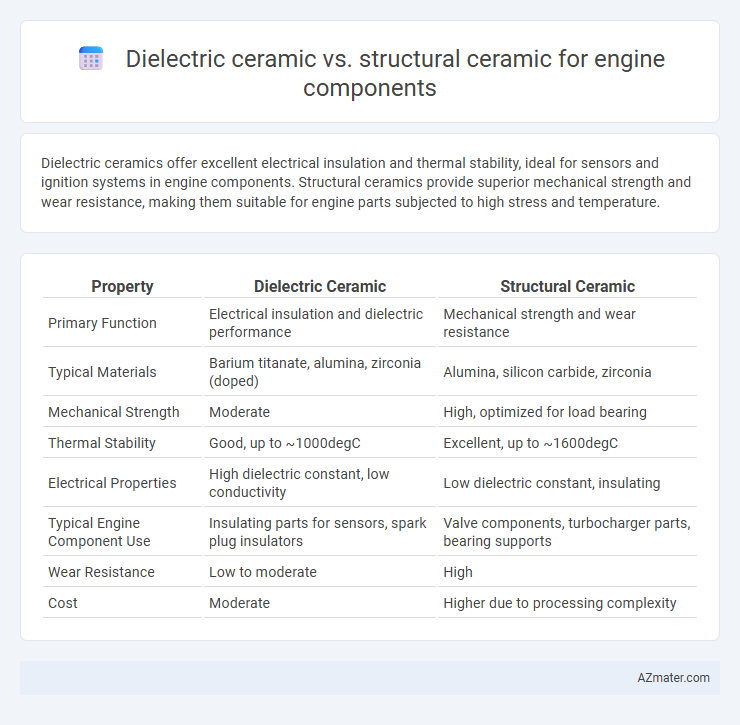Dielectric ceramics offer excellent electrical insulation and thermal stability, ideal for sensors and ignition systems in engine components. Structural ceramics provide superior mechanical strength and wear resistance, making them suitable for engine parts subjected to high stress and temperature.
Table of Comparison
| Property | Dielectric Ceramic | Structural Ceramic |
|---|---|---|
| Primary Function | Electrical insulation and dielectric performance | Mechanical strength and wear resistance |
| Typical Materials | Barium titanate, alumina, zirconia (doped) | Alumina, silicon carbide, zirconia |
| Mechanical Strength | Moderate | High, optimized for load bearing |
| Thermal Stability | Good, up to ~1000degC | Excellent, up to ~1600degC |
| Electrical Properties | High dielectric constant, low conductivity | Low dielectric constant, insulating |
| Typical Engine Component Use | Insulating parts for sensors, spark plug insulators | Valve components, turbocharger parts, bearing supports |
| Wear Resistance | Low to moderate | High |
| Cost | Moderate | Higher due to processing complexity |
Introduction to Ceramic Materials in Engine Components
Dielectric ceramics in engine components provide excellent electrical insulation and thermal stability, crucial for sensors and ignition systems. Structural ceramics offer high mechanical strength, wear resistance, and thermal shock tolerance, making them ideal for engine parts subjected to extreme stresses such as valves and turbine blades. Their combined properties enhance engine performance, durability, and efficiency under harsh operating conditions.
Overview of Dielectric Ceramics
Dielectric ceramics, characterized by their high electrical insulation and low dielectric loss properties, are essential in engine components that require electrical isolation and thermal stability. These materials exhibit exceptional resistance to electrical currents, making them ideal for sensors, ignition systems, and electronic modules within automotive engines. Compared to structural ceramics, dielectric ceramics prioritize electrical performance over mechanical strength, emphasizing stable permittivity and breakdown voltage under high-temperature conditions.
Overview of Structural Ceramics
Structural ceramics, utilized in engine components, exhibit exceptional hardness, high-temperature resistance, and wear durability, making them ideal for demanding environments such as combustion chambers and turbine blades. These ceramics, typically composed of materials like silicon nitride, alumina, and zirconia, offer superior mechanical strength and thermal stability compared to dielectric ceramics. Their ability to withstand thermal shock and corrosion while maintaining structural integrity enhances engine performance and longevity.
Key Material Properties Comparison
Dielectric ceramics exhibit high electrical insulation, low dielectric loss, and excellent thermal stability, making them ideal for sensor and ignition components in engines. Structural ceramics, such as alumina and silicon carbide, offer superior mechanical strength, wear resistance, and fracture toughness, essential for components subjected to high stress and thermal shock. Comparing key material properties, dielectric ceramics prioritize electrical performance and insulation, while structural ceramics focus on load-bearing capacity and durability under extreme operating conditions.
Thermal and Mechanical Performance
Dielectric ceramics for engine components offer excellent electrical insulation and high thermal stability, with thermal conductivities ranging from 1 to 30 W/m*K, suitable for managing heat without electrical interference. Structural ceramics, such as silicon carbide and alumina, provide superior mechanical strength with flexural strengths exceeding 400 MPa and fracture toughness above 4 MPa*m^0.5, enabling them to withstand high stress and thermal shock in engine environments. Thermal expansion coefficients for structural ceramics typically range from 4 to 8 x 10^-6 /K, allowing better dimensional stability under rapid temperature changes compared to dielectric ceramics.
Electrical Insulation Capabilities
Dielectric ceramics exhibit superior electrical insulation capabilities compared to structural ceramics, making them ideal for engine components requiring high-voltage resistance and minimal electrical conductivity. These materials, such as alumina and zirconia, provide excellent dielectric strength and low dielectric loss, which protect sensitive engine electronics from electrical interference and breakdown. Structural ceramics prioritize mechanical strength and thermal stability but generally offer lower electrical insulation, limiting their use in electrically sensitive engine environments.
Typical Engine Applications for Dielectric Ceramics
Dielectric ceramics are primarily used in engine components requiring excellent electrical insulation and high-frequency signal transmission, such as sensors, spark plugs, and ignition systems. These ceramics exhibit superior dielectric strength and thermal stability, essential for maintaining performance under high-temperature engine conditions. In contrast, structural ceramics are employed in components needing mechanical strength and wear resistance, like valves, turbocharger rotors, and engine blocks.
Typical Engine Applications for Structural Ceramics
Structural ceramics are extensively used in engine components such as turbine blades, valve seals, and piston rings due to their exceptional hardness, high temperature resistance, and mechanical strength. Unlike dielectric ceramics primarily used for electrical insulation and sensing, structural ceramics withstand extreme thermal and mechanical stresses in combustion engines, enhancing durability and performance. Typical applications include ceramic coatings for engine parts to reduce wear and improve heat resistance in aerospace and automotive industries.
Advantages and Limitations of Each Ceramic Type
Dielectric ceramics offer excellent electrical insulation and high thermal stability, making them ideal for engine components exposed to high voltages and temperature fluctuations, but they typically lack the mechanical strength required for load-bearing applications. Structural ceramics provide superior hardness, wear resistance, and mechanical strength, which enhance engine durability and performance under extreme stress, yet they are more brittle and can suffer from impact damage or fracture. Selecting between dielectric and structural ceramics depends on balancing electrical insulation needs with mechanical and thermal demands within specific engine environments.
Future Trends in Ceramic Engine Component Design
Dielectric ceramics offer superior electrical insulation and thermal stability, making them ideal for sensors and ignition systems in advanced engines, while structural ceramics provide exceptional strength and wear resistance for critical load-bearing components. Future trends emphasize the integration of multifunctional ceramics combining dielectric properties with enhanced toughness, driven by developments in nano-engineering and additive manufacturing techniques. These advancements aim to improve engine efficiency, reduce weight, and extend component lifespan under extreme thermal and mechanical stress.

Infographic: Dielectric ceramic vs Structural ceramic for Engine component
 azmater.com
azmater.com